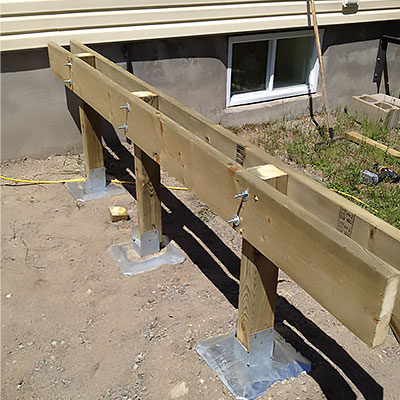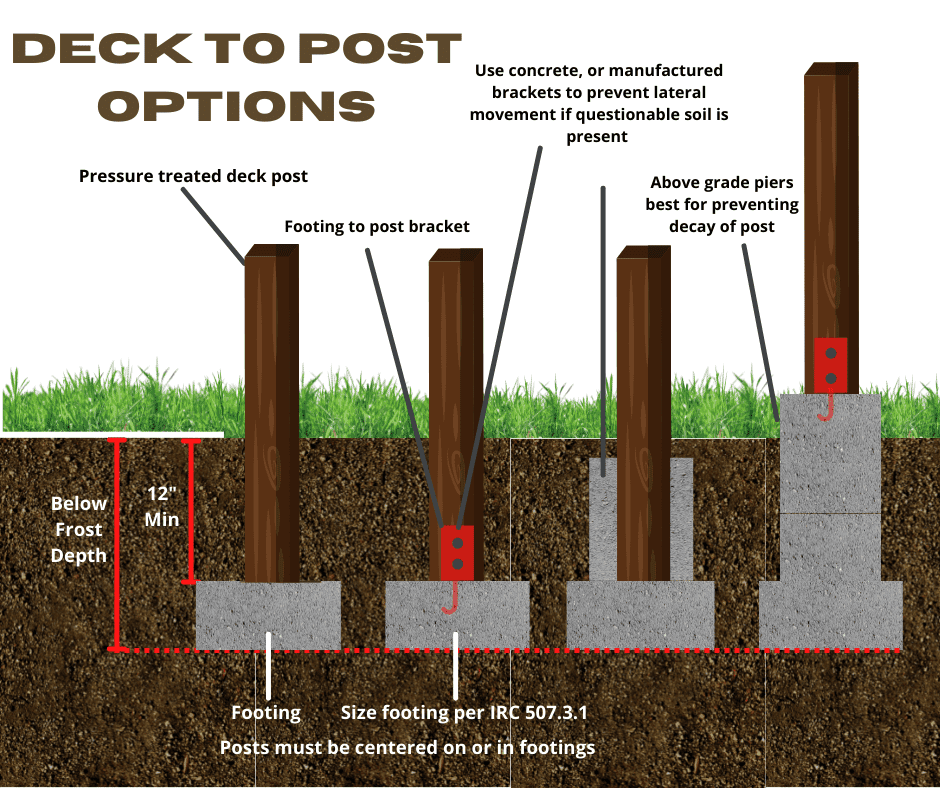From Concept to Concrete: The Important Function of Deck Footings in Sturdy and Safe Decks
Wiki Article
Picking the Right Deck Footings for Stability and Sturdiness
The long life and security of your deck depend heavily on the kind of footings you pick, as they supply the crucial assistance and security to stand up to the examination of time. In this conversation, we will discover the different types of deck grounds, think about the essential factors to consider when making a decision, and dig right into the pros and cons of various options.Kinds Of Deck Grounds
There are several kinds of deck footings that can be used, each offering one-of-a-kind advantages and factors to consider. One common kind of ground is the concrete pier footing. These grounds are composed of a cylindrical hole loaded with concrete, which supplies a strong foundation for the deck blog posts. Concrete pier footings are reasonably very easy to mount and provide superb security, making them a preferred selection for many deck jobs.Another kind of footing is the helical pile footing. Helical stacks are steel shafts with helical plates affixed to them. These grounds are set up by screwing them right into the ground, which creates a safe and secure foundation for the deck. Helical heap grounds are ideal for areas with challenging soil problems, as they can be set up in nearly any kind of kind of soil. If needed., they also permit for simple change and leveling of the deck.
Conversely, some building contractors select precast concrete grounds. These grounds are constructed from sturdy concrete and be available in numerous forms and dimensions to suit various deck designs. Precast concrete grounds are hassle-free to mount and provide a stable base for the deck structure.
Lastly, one more alternative is the post-in-anchor footing system. This kind of ground entails driving a steel support right into the ground and attaching it to the deck blog post. It provides adaptability in terms of placing the deck messages and appropriates for decks with lightweight frameworks.
When choosing the ideal type of deck footing, it is important to take into consideration variables such as soil problems, deck load, and regional building ordinance (Deck Footings). Consulting with a professional specialist or architectural engineer can assist ensure the suitable ground is chosen for a risk-free and secure deck
Aspects to Take Into Consideration When Choosing Footings
When choosing the ideal footings for a deck, it is vital to carefully think about numerous variables such as soil conditions, deck lots, and adherence to neighborhood building codes. These elements play a considerable function in making certain the security and sturdiness of the deck framework.Among the key factors to consider is the soil conditions. The sort of soil on which the deck will be developed figures out the sort of grounds required. For example, decks improved loosened or sandy dirts might need deeper grounds to offer ample support and protect against settling. On the various other hand, decks constructed on clay or expansive soils might require footings that can fit the dirt's tendency to increase and contract.
An additional vital variable is the deck load. The weight of the deck, consisting of the products made use of and any kind of possible real-time loads such as furniture or events, need to be thought about when selecting footings. The footings should be created to bear the weight of the deck and distribute it equally to avoid any architectural problems or failings.
Finally, adherence to local structure codes is extremely important. Building regulations differ from region to area, and it is vital to follow the particular requirements established by the regional authorities. Deck Footings. These codes guarantee that the deck is built securely and satisfies the required standards for structural integrity and load-bearing ability
Concrete Grounds: Advantages And Disadvantages

Concrete grounds supply numerous benefits and drawbacks when used as the foundation for a deck. On the positive side, concrete grounds supply outstanding security and durability. Concrete is a solid and stiff material that can support hefty tons and stand up to numerous weather. It additionally has a long lifespan, making it a dependable selection for lasting usage.
One more advantage of concrete footings is their flexibility. They can be poured into different shapes and sizes to accommodate numerous deck designs and configurations. Concrete grounds can be tailored to fit the details demands and needs of the deck framework.
Nevertheless, there are likewise some disadvantages to using concrete footings. One significant negative aspect is the expense and labor involved in their setup. Concrete footings require excavation and typically require the help of heavy equipment. This can boost the general expense of the deck job and might call for professional support.

Helical Piers Vs. Sonotubes: Which Is Much better?
In taking into consideration the foundation options for a deck, the comparison between helical piers and sonotubes is critical in determining the exceptional choice. Helical piers, likewise understood as screw heaps, are steel shafts with helical plates affixed to them. They are turned into the ground using hydraulic machinery, supplying a durable and stable structure for the deck. On the other hand, sonotubes are cylindrical kinds made from cardboard or fiber product that are loaded with concrete. They are placed in an opening explored the ground and give assistance for the deck.When it comes to stability and toughness, helical piers have the top hand. The helical plates on the piers develop a strong grip with the dirt, avoiding any kind of movement or moving of the deck. This is especially beneficial in locations with unsteady or shifting dirt conditions. Sonotubes, on the visit the site various other hand, rely only on the concrete filling up for stability, which might not provide the very same level of strength and resistance.
In terms of installation, helical piers are relatively less complicated and faster to install compared to sonotubes. The hydraulic machinery made use of to twist the piers into the ground makes certain a quick and reliable procedure. Sonotubes, on the other hand, need digging openings and putting concrete, which can be labor-intensive and time-consuming.
In addition, helical piers are an even more versatile choice. If required, they can be used in various soil conditions and can be changed or enhanced. Sonotubes, on the other hand, may need added support, such as rebar, in specific dirt problems or areas with high lots needs.
Selecting the Right Footings for Your Deck's Dimensions
For ideal architectural stability, it is important to carefully select the suitable grounds that align with the dimensions of your deck. The dimensions of your deck, including its width, length, and height, play a considerable duty in determining the type and size of grounds called for.When picking grounds for your deck, it is necessary to consider the load-bearing capacity of the soil. The weight of the deck, incorporated with the weight of any kind of furniture or individuals on it, applies a substantial pressure on the grounds (Deck Footings). It is vital to pick grounds that can appropriately support this weight without moving or sinking over time.
The dimension and form of the grounds ought to likewise be considered. Larger decks with better dimensions require larger footings to supply sufficient security and support. The shape of the footings, whether they are square or rounded, depends upon the style and layout of about his the deck. Additionally, the depth at which the grounds are installed should be identified based on the frost line in your region to stop any heaving or changing as a result of freezing temperatures.
Verdict
In verdict, choosing the best deck grounds is critical for making sure security and sturdiness. Variables such as the kind of footings, the deck's measurements, and the pros and disadvantages of different choices need to be considered.These grounds consist of a round opening loaded with concrete, which provides a solid foundation for the deck messages. Concrete pier footings are fairly simple to set up and use superb security, making them a informative post preferred selection for many deck projects.
Precast concrete footings are convenient to install and give a steady base for the deck structure.
It provides flexibility in terms of placing the deck messages and is suitable for decks with light-weight structures.
Concrete grounds provide numerous benefits and downsides when used as the foundation for a deck.
Report this wiki page